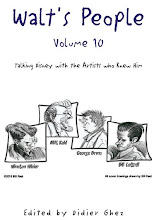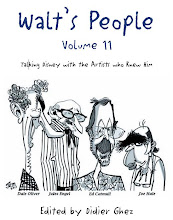Obviously, two of the most expected Disney History books of the year are those which JB Kaufman has written about Snow White and the Seven Dwarfs. I can't wait to hold both of them in my hands soon. To get us all even more excited about them, I had the pleasure of interviewing JB recently about "the main book": The Fairest One of All. Tomorrow I will also interview JB about the catalog of the exhibition, Snow White and the Seven Dwarfs: The Art and Creation of Walt Disney's Classic Animated Film.
Didier Ghez Why and how did you decide to work on a new book about the making of Snow White and the Seven Dwarfs?
JB Kaufman: I think I had
always had the idea in the back of my mind. There have been some very good
books about Snow White, but I always
had a feeling there was a lot more to the story that hadn’t been recorded yet.
Then when I was in San Francisco, talking with Diane Disney Miller about
another Walt Disney Family Foundation project, we started discussing the idea
of pursuing this in a serious way. I think she thought of the idea and she
thinks I thought of it, so let’s compromise and say we both thought of it at the
same time. But no matter who thought of it, I think we were both excited right
away about undertaking this project.
DG: What were some of the most interesting documents and sources of information you
uncovered while conducting research for the book?
JBK: On one hand,
there’s such a tremendous wealth of Snow
White documentation that it’s hard to single out individual documents—the
impressive thing is just the sheer volume of material. It took literally years
to go through it all, but it was definitely worth it, because when you start
with the ideas discussed in story conferences and follow them all the way
through production—by way of the drafts, the sweatbox notes, the exposure
sheets, sometimes the retake orders, and everything in between—you get a real
sense of how they developed and evolved on the way to the screen. The Walt
Disney Archives and Animation Research Library were indispensable sources for
this information, of course (a big selection of the Snow White cutting records was unearthed while I was doing my
research, so I latched onto those too). And the Walt Disney Family Foundation’s
own collection was also invaluable, and filled in a lot of gaps in the
production story.
On
the other hand, I wanted to reconstruct the context of the movie by tracing the
history of the “Snow White” story before Walt tackled it, so I wound up getting
a crash course in the history of folklore. And some wonderful documents turned
up in that part of my research, too. Maria Tatar, an internationally known
folklore authority, gave me her very kind assistance in tracing the roots of
the story, and other specialists illuminated specific aspects of it. And I
learned a lot about the various stage versions at some of the theatrical
archives in New York. Along with that, my friends at some of the major film archives helped me turn up some
wonderful documents and images from earlier film versions of the story.
DG: Over the years, did you interview any of the artists who had worked on the
movie?
JBK: Yes,
as a matter of fact. I’m amazed to realize that it’s been over 30 years (!)
since I first started seriously researching film history, and at that time
several of the key Snow White artists
were still alive and happy to talk about their experiences. At the time I
wasn’t actively pursuing the idea of a Snow
White book, but several of the Disney artists I interviewed—in particular
Bill Cottrell, Grim Natwick, Ken O’Connor and a few others—had some extensive
and insightful comments on this feature that had been such a major event in
their lives. So when we did decide to undertake this book project, those
interviews were invaluable.
DG: What are some of the key discoveries you made while tackling this project?
JBK: There were quite
a few, but I think the main thing that impressed me was watching Walt’s creative
process at work. It’s one thing to be told that Walt Disney had a creative
mind, but it’s a different thing to see it in action. At the beginning of story
development he really is open to any and all ideas, and his own ideas evolve
considerably in the course of production. As they do, they get increasingly
elaborate and ambitious. And as he sifts through this incredible wealth of
ideas and settles on the direction he wants to go, he gets very specific and
detailed, and constantly refines and perfects every aspect of the picture as he
goes along. He can shift instantly between the grand overall view and the
meticulous, painstaking details, and he manages to stay focused on both at the
same time.
DG: What are the most important chapters in the book from your point of view?
JBK: They’re
all important! There’s one very long chapter that examines the film in detail,
section by section, delving into the production of each sequence and the
finished result on screen. That one chapter by itself accounts for nearly half
the page count of the entire book, so it will probably be a key chapter for
most readers. In the last section of the book, about the aftermath of Snow White, there’s a chapter about
return appearances by the Seven Dwarfs—their scenes in public-service shorts
produced during the war, and so on. I love to find the unexplored nooks and
crannies of film history, so that’s a pretty important chapter for me.
DG: Are you working on any other books about Disney at the moment?
JBK: Yes,
actually I’m neck-deep in researching a followup book on the making of Pinocchio, and that’s turning out to be
a fascinating subject too. Stay tuned!























5 comments:
Brilliant. For me at least, Snow White was the best in terms of story, while Pinocchio was the best from an artistic standpoint. I can't wait to see the two SW books and then will hold my breath waiting for the Pinocchio one.
Can't wait for this and now the Pinocchio book.
Great interview, David. JB's research and analysis are always impeccable. Can't wait for the book.
You mean Didier, right?
I hope the book goes into Natalie Kalmus' input into color choices made in the film's palette. Her commentary was invaluable.
Post a Comment